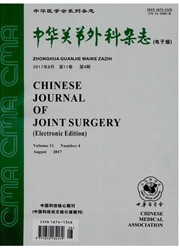

 中文摘要:
中文摘要:
目的 分析髋关节正位DR片Singh指数与髋关节置换术后关节功能间的相关性,评价Singh指数对髋关节置换术后功能的预测能力.方法 对2010年1月至2012年1月在山西医科大学第二医院行髋关节置换术的175例患者进行随访,分析患者术前髋关节正位DR片Singh指数与术后1年患者髋关节Harris评分的Spearman相关性.结果 共获得资料完整病例175例,男81例,女94例.其中骨关节炎病例28例,男12例,女16例;股骨颈骨折病例106例:男38例,女68例;股骨头坏死41例:男30例,女11例.股骨颈骨折患者Singh指数与Harris评分相关性较高(r=0.708,P〈0.01),股骨头坏死患者Singh指数与Harris评分相关性较低(r=0.642,P〈0.01),骨关节炎患者Singh指数与Harris评分相关性最低(r=0.541,P〈0.01),均有统计学意义,男患者Singh指数与Harris评分相关性较女患者高,但差异没有统计学意义.结论 股骨颈骨折行人工股骨头置换术患者可根据股骨近端Singh指数预测术后关节功能状态,但对于股骨头坏死和髋关节骨性关节炎行全髋关节置换术患者Singh指数对术后关节功能预测能力相对较差.
 英文摘要:
英文摘要:
Objective To explore the relationship between Singh index and post-operative Harris score, as well as the possibility of predicting the outcomes after the hip arthroplasty by Singh index. Methods A follow-up questionnaire was conducted in 175 patients who bad undergone the hip arthroplasty during 2010-2012 in our institute. Singh index of the preoperative digital radiography (DR) and the Harris score one year after operation were recorded. The correlation between the Singh index and the Harris score was analyzed. Results 175 questionnaires were completed. 81 cases were males and 94 cases were females. In the 175 cases, there were 28 cases of osteoarthritis, 106 cases of femoral neck fracture and 41cases of osteonecrosis of the femoral head. The correlation between the Singh index and the Harris score was higher in the femoral neck fracture patients (r = 0, 708, P 〈 0. 01 ) compared with that in the femoral neck fracture patients (r = 0. 642, P 〈 0. 01 ) ; the correlation in the osteoarthritis patients was the lowest ( r =0. 541, P 〈0.01 ). The correlation of the male was higher than that of the female, but there was no statistically significant difference. Conclusion The preoperative Singh index can partially predict the outcomes of the hip arthroplasty in the femoral neck fracture patients, but the predicting ability of Singh index for the outcomes of the hip arthroplasty in the femoral neck fracture patients and osteoarthritis patients is limited.
 同期刊论文项目
同期刊论文项目
 同项目期刊论文
同项目期刊论文
 Disrupting the Indian hedgehog signaling pathway in vivo attenuates surgically induced osteoarthriti
Disrupting the Indian hedgehog signaling pathway in vivo attenuates surgically induced osteoarthriti 期刊信息
期刊信息
